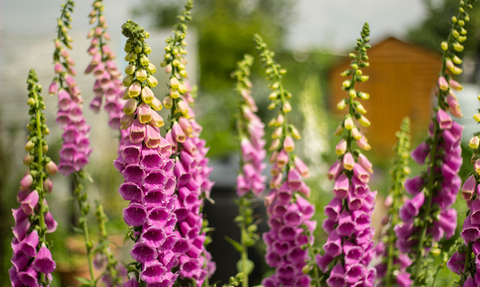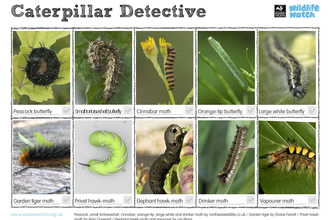
Foxgloves (c) Euan Moorey
Summer
Summer is a time of colour and activity, both by day and by night. Dragonflies and damselflies dart along canals and waterways, while butterflies flit between flowers in the meadows and reptiles bask in the sunshine. As darkness falls bats swoop through the air, moths start the pollinator night shift and glow worms light up the long grass.
From pine marten kits venturing out of their dens to large blue butterflies, find out more about what wildlife is up to in summer. Click the (i) icons to find the image credit, or on the images themselves to find out more about what that species is up.
Animals, birds, amphibians and more!
In later spring and summer, we see many migratory birds return to the UK. Keep your eyes and ears peeled for swifts, cuckoos and nightingales before they head back to Africa and Sub-Saharan Africa for the winter months.
June sees pine marten kits, badger cubs, and fox cubs start to leave their dens and explore the surrounding forest, and bats are born. Later on in July you can see peregrine falcons juveniles and other birds start taking their first practice flights under the watchful eyes of their parents.
What insects are active?
Summer is when insect life is at its most abundant, with meadows, gardens and green spaces buzzing with life. Dragonflies take to the wing, butterflies flit through the meadows, and grasshoppers jump through the long grasses.
It's not just birds that migrate to the UK - some butterfly species do too! The UK has 59 species of butterflies - 57 resident species and two regular migrants: the painted lady and the clouded yellow.
Moth week falls on the last week of July, and is a great time to spot some of our weird and wonderful night time pollinators.
If you've spotted a caterpillar in your garden and would like to know what it is, our handy caterpillar guide covers the ones you're most likely to find:
For the plant enthusiasts
Wildflower meadows and gardens burst into life in the summer months, their vibrant colours humming with the insects that inhabit them.
How to help wildlife out in a heatwave
While we think about how to stay cool during the summer months, here are some tips to help your local wildlife out during a heatwave.
Provide enough water
It is as important for wildlife as it is for us to keep hydrated. Provide a shallow dish of water for thirsty birds, mammals, and even insects. Putting a rock in the centre gives insects a way to dry off if they fall in.
Top up your bird feeders
Apple chunks or soaked raisins are great additions to bird feeders, or on the floor for thrushes and other animals. Please note that raisins can be harmful to cats and dogs, so don’t put them where they can reach them.
Looking for somewhere to buy bird food? Our partners at Vine House Farm offer a great range of wild bird products, and give 4% of every purchase to Gloucestershire Wildlife Trust. If you're a new customer, Vine House Farm will also give an extra £10 donation!
Help out the hedgehogs
Invertebrates can be harder to find during the hot weather. Setting out some dry dog or cat food during prolonged heatwaves can give them a meal they desperately need, and a bowl of water would be greatly appreciated too. Do not put out meal worms for hedgehogs, they are not good for them!
Provide shade
Providing some shelter from the sun can make all the difference for frogs, toads, and newts, but also for less aquatic creatures. Logs, stone slabs, long grass, and rockeries all give great cover.
Top up the bird bath
...or make one! Birds need to bathe to keep their feathers in tip top condition, so making sure there is fresh clean water will help them out. If you don’t have access to a garden, secure a small source of water on the outside of a window ledge for insects, or purchase a bird bath that can clip to balcony railings.
Spotter sheets
Head out into the garden, woodland, or countryside with these spotter sheets and see which ones you can find.








































